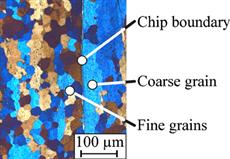Jul 26 2013
Aluminum recycling has become a successful business since its inception a century ago. Nearly a third of the aluminum produced in the United States is made from aluminum scraps that have been recycled in a process—usually remelting—that uses only 5 to 10 percent of the energy it takes to extract aluminum from mined bauxite ore.
 A micrograph from Misiolek’s collaboration with researchers at the Technical University of Dortmund shows grain growth that has been prevented because of the presence of a chip boundary in a chip-based specimen.
A micrograph from Misiolek’s collaboration with researchers at the Technical University of Dortmund shows grain growth that has been prevented because of the presence of a chip boundary in a chip-based specimen.
But there are limitations to the remelting of aluminum, says Wojciech Misiolek, the director of Lehigh’s Institute for Metal Forming and the Loewy Chair in Materials Forming and Processing.
Significant metal losses can occur when aluminum is remelted. Machine chips and other fine pieces of scrap are difficult to remelt. Contamination and impurities can cause the mechanical properties of recycled aluminum, especially its strength and ductility, to be inferior to those of pure aluminum. And remelting itself is energy-intensive.
In an effort to make aluminum production a more sustainable endeavor, materials scientists are investigating solid state recycling of aluminum chips by extrusion, which promises higher metal yield and lower heat use—and therefore energy consumption—than conventional recycling based on remelting.
The role of the extrusion die
A group that includes researchers from Lehigh and the Technical University (TU) of Dortmund in Germany has found that using special extrusion dies improves the mechanical properties of recycled aluminum by allowing more strain and shearing during metal flow.
Using transmission electron microscopy (TEM), the group is comparing the evolution of the microstructure, including the size and distribution of critical grain boundaries, of aluminum that is extruded through three different types of dies.
In the past year, the group has reported its results twice in Materials Science and Engineering A and once in the CIRP Annals of Manufacturing Technology. Both journals are published by Elsevier.
In its experiments, the group processed machined aluminum chips into a cylindrically shaped billet and extruded the billet, pushing it through a die.
As aluminum flows through a die, it deforms, changing in shape and size. Shearing occurs as the rate of flow increases and decreases, causing the fracture of an oxide layer, which covers each chip and which can act as a barrier that prevents bonding.
The researchers’ goal is to learn the amounts of shearing and deformation that promote optimal bonding between the aluminum chips. They hope to accomplish this by guiding the development of the aluminum’s microstructure through the controlled fracture and dispersion of the oxide.
“We are trying to understand the critical conditions necessary to guarantee the good bonding of chips,” says Misiolek. “Our goal is to control the microstructure and improve the mechanical properties of the aluminum.”
Identifying the “sweet spot” in shearing
While a continuous oxide layer can impede material bonding, says Misiolek, the researchers have learned that the right amount of the fractured oxide particles can result in a new and promising microstructure.
“TEM allows us to determine what shearing conditions are necessary to break the oxide layer and simultaneously preserve it to such an extent that it acts as a barrier to the growth of grain boundaries.
“We want to find this ‘sweet spot’ in shearing. We’re hoping this will enable us to control the mechanical properties of aluminum, especially its strength and ductility.”
The TU Dortmund researchers experimented with a conventional flat-face die used in the production of solid aluminum profiles, a porthole die used mostly to make complex hollow and semi-hollow profiles, and an ECAP (Equal Channel Angular Pressing) die, which guarantees the highest level of shear deformation and, therefore, modification of the microstructure.
While the aluminum extruded through the porthole dies possessed 80 percent more ductility than the aluminum extruded through the flat-face die, the researchers said, “the use of the ECAP die led to the highest strength and ductility of chip-based extrudates for the three dies.”
Masashi Watanabe, associate professor of materials science and engineering at Lehigh, obtained TEM images of the microstructure of the recycled aluminum.
“With TEM, we can see grains, dislocations and other defects in the microstructure,” said Watanabe. “We were able to confirm that even at a lower temperature, severe plastic deformation [caused by the extrusion] changed the microstructure significantly, creating nanosized grains that improved the mechanical properties.”
In 2011-12, Misiolek spent six months at TU’s Institute for Metal Forming and Light Construction as Mercator Visiting Professor. His stay was funded by the German Research Foundation (Deutsche Forschungsgemeinschaft-DFG).
Last year, Matthias Haase of TU Dortmund’s Institute for Metal Forming and Light Construction spent two months as a visiting researcher at Lehigh’s Institute for Metal Forming.